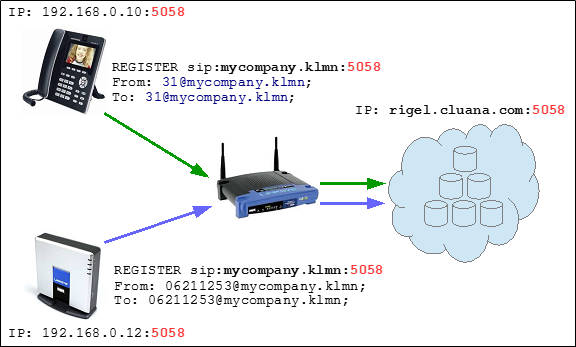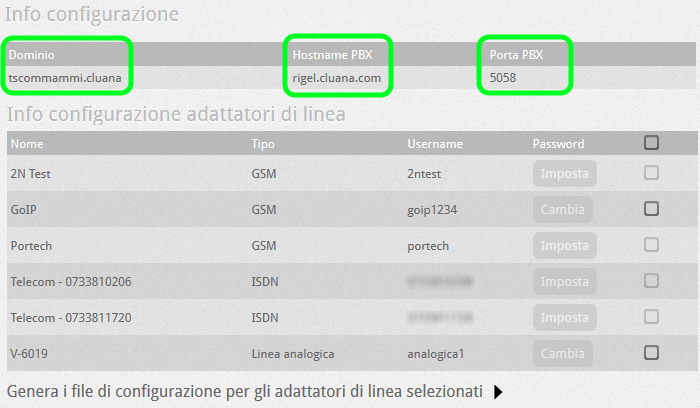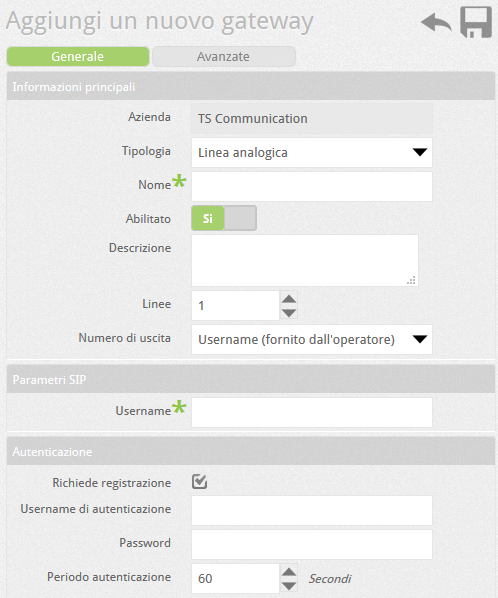Analog lines are traditional telephone lines that allow you to make only one call at a time: thanks to the popularity of VoIP, recently operators (including Telecom Italia) can provide routers that emulate analog lines, however, using VoIP as a transmission protocol in the route from the customer. to the control unit, but to all intents and purposes for the VOIspeed switchboard these are analog lines. To interface with these lines, a hardware line adapter with FXO interface, such as the V-6019, is therefore required.
CONFIGURE A NEW ANALOG GATEWAY IN THE VOISPEED SWITCHBOARD (ON PREMISES VERSION)
From the Settings – Gateway menu, add a new gateway and set the parameters as follows:
Type: Analog line
Name (required): convenience name (will be shown in the call statistics)
Lines: 1 Exit number: leave “Username (provided by the operator)”. In the SIP Parameters section, configure the following data:
Proxy: IP address of the line adapter: port (eg. For the V-6019: 192.168.0.110:5062).
Domain: IP address of the line adapter (eg. 192.168.0.110).
Username: any non-empty string (eg “voispeed”)
RTP Stream Tracker: No.
Requires registration: No. |
 |
Once the configuration is complete, save the settings with OK.
How to configure the FXO V-6019 adapter
ANALOG GATEWAY CONFIGURATION IN THE VOISPEED SWITCHBOARD (CLOUD / UCLOUD VERSION)
The architecture of VOIspeed Cloud is different from that of an on-premises installation, the differences are few but substantial and are reflected in the configuration of the telephone terminals and gateways. The essential points can be summarized in the following:
- The parameters relating to the company domain, the outbound proxy and the SIP working port are assigned by the system and cannot be changed. The working port is the one used by the PBX and should be used, whenever possible, also by all terminals and gateways. The purpose is to minimize the probability of activating the SIP ALG present in the router. The example in the figure below shows the three parameters for the Cloud platform, respectively mycompany.klmn, rigel.cluana.com and 5058;
- The ISDN or FXO telephone gateways must register on the server with a username and password, in the same way as a telephone terminal;
- The SIP port 5060 is no longer the default port, so if VoIP operators are used, this port must be explicitly indicated in the proxy field;
- G.729 must always be available between the audio codecs of terminals and gateways. To ensure the highest quality in any situation, the priority of the codecs should be set in descending order of quality. For example: L16, PCMA, G.729 or G.722, PCMA, G.729.
|
 |
VOISPEED CLOUD CONFIGURATION PANEL
In the VOIspeed Cloud configuration panel, by clicking on the Toolbox – Info config menu. a summary screen will be presented like the one below where, in the first line, the three configuration parameters indicated in point 1) are shown. In particular, the company domain will be indicated in the Domain column; in Hostname PBX the outbound proxy, in Port PBX, the working UDP port. These parameters will be used both for the configuration of the telephone terminals and for the telephone gateways that will register on the PBX in the cloud.  |
 |
VOISPEED CLOUD / UCLOUD CONFIGURATION PANEL
In the Cloud environment, as mentioned, the gateways must register with the server with their own account. They then behave like terminals, while the PBX accepts their registration. The configuration screen is therefore as in the figure to the side. Type: Analogue Line
Name: convenience name (required)
Enabled: Yes
Lines: 1
Exit Number: see above Username: is the username of the account intended for the gateway
Requires Registration: Select Yes
Authentication username / Password: account registration credentials for the gateway (coincides with the Username specified above) Authentication period: set the registration time (typically 60 or 120 seconds).
NOTE: all the account parameters entered on this page must correspond to the same values set on the gateway. |
 |







